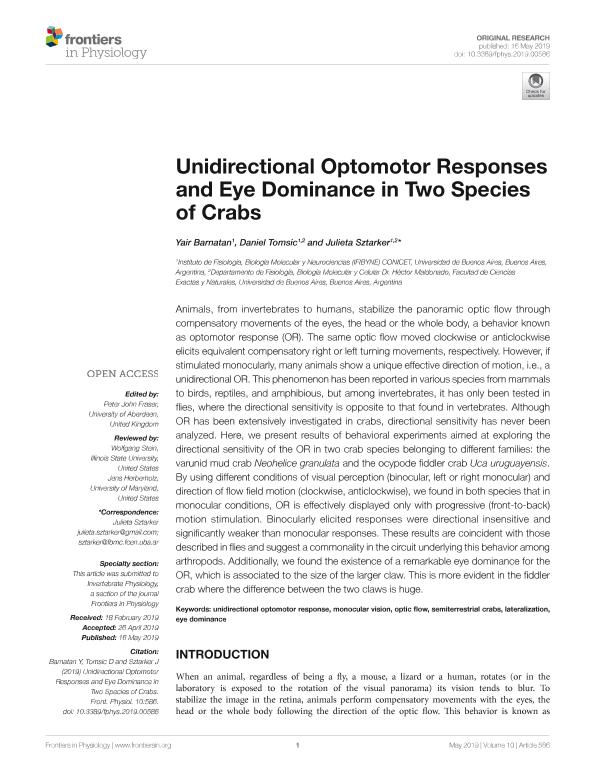Mostrar el registro sencillo del ítem
dc.contributor.author
Barnatan, Yair Benjamín

dc.contributor.author
Tomsic, Daniel

dc.contributor.author
Sztarker, Julieta

dc.date.available
2020-12-23T16:41:29Z
dc.date.issued
2019-05
dc.identifier.citation
Barnatan, Yair Benjamín; Tomsic, Daniel; Sztarker, Julieta; Unidirectional Optomotor Responses and Eye Dominance in Two Species of Crabs; Frontiers Media S.A.; Frontiers in Physiology; 10; 5-2019; 1-11
dc.identifier.uri
http://hdl.handle.net/11336/121138
dc.description.abstract
Animals, from invertebrates to humans, stabilize the panoramic optic flow through compensatory movements of the eyes, the head or the whole body, a behavior known as optomotor response (OR). The same optic flow moved clockwise or anticlockwise elicits equivalent compensatory right or left turning movements, respectively. However, if stimulated monocularly, many animals show a unique effective direction of motion, i.e., a unidirectional OR. This phenomenon has been reported in various species from mammals to birds, reptiles, and amphibious, but among invertebrates, it has only been tested in flies, where the directional sensitivity is opposite to that found in vertebrates. Although OR has been extensively investigated in crabs, directional sensitivity has never been analyzed. Here, we present results of behavioral experiments aimed at exploring the directional sensitivity of the OR in two crab species belonging to different families: the varunid mud crab Neohelice granulata and the ocypode fiddler crab Uca uruguayensis. By using different conditions of visual perception (binocular, left or right monocular) and direction of flow field motion (clockwise, anticlockwise), we found in both species that in monocular conditions, OR is effectively displayed only with progressive (front-to-back) motion stimulation. Binocularly elicited responses were directional insensitive and significantly weaker than monocular responses. These results are coincident with those described in flies and suggest a commonality in the circuit underlying this behavior among arthropods. Additionally, we found the existence of a remarkable eye dominance for the OR, which is associated to the size of the larger claw. This is more evident in the fiddler crab where the difference between the two claws is huge.
dc.format
application/pdf
dc.language.iso
eng
dc.publisher
Frontiers Media S.A.

dc.rights
info:eu-repo/semantics/openAccess
dc.rights.uri
https://creativecommons.org/licenses/by/2.5/ar/
dc.subject
EYE DOMINANCE
dc.subject
LATERALIZATION
dc.subject
MONOCULAR VISION
dc.subject
OPTIC FLOW
dc.subject
SEMITERRESTRIAL CRABS
dc.subject
UNIDIRECTIONAL OPTOMOTOR RESPONSE
dc.subject.classification
Otras Ciencias Biológicas

dc.subject.classification
Ciencias Biológicas

dc.subject.classification
CIENCIAS NATURALES Y EXACTAS

dc.title
Unidirectional Optomotor Responses and Eye Dominance in Two Species of Crabs
dc.type
info:eu-repo/semantics/article
dc.type
info:ar-repo/semantics/artículo
dc.type
info:eu-repo/semantics/publishedVersion
dc.date.updated
2020-11-13T20:49:26Z
dc.identifier.eissn
1664-042X
dc.journal.volume
10
dc.journal.pagination
1-11
dc.journal.pais
Estados Unidos

dc.description.fil
Fil: Barnatan, Yair Benjamín. Consejo Nacional de Investigaciones Científicas y Técnicas. Oficina de Coordinación Administrativa Ciudad Universitaria. Instituto de Fisiología, Biología Molecular y Neurociencias. Universidad de Buenos Aires. Facultad de Ciencias Exactas y Naturales. Instituto de Fisiología, Biología Molecular y Neurociencias; Argentina
dc.description.fil
Fil: Tomsic, Daniel. Consejo Nacional de Investigaciones Científicas y Técnicas. Oficina de Coordinación Administrativa Ciudad Universitaria. Instituto de Fisiología, Biología Molecular y Neurociencias. Universidad de Buenos Aires. Facultad de Ciencias Exactas y Naturales. Instituto de Fisiología, Biología Molecular y Neurociencias; Argentina. Universidad de Buenos Aires. Facultad de Ciencias Exactas y Naturales. Departamento de Fisiología, Biología Molecular y Celular; Argentina
dc.description.fil
Fil: Sztarker, Julieta. Universidad de Buenos Aires. Facultad de Ciencias Exactas y Naturales. Departamento de Fisiología, Biología Molecular y Celular; Argentina. Consejo Nacional de Investigaciones Científicas y Técnicas. Oficina de Coordinación Administrativa Ciudad Universitaria. Instituto de Fisiología, Biología Molecular y Neurociencias. Universidad de Buenos Aires. Facultad de Ciencias Exactas y Naturales. Instituto de Fisiología, Biología Molecular y Neurociencias; Argentina
dc.journal.title
Frontiers in Physiology
dc.relation.alternativeid
info:eu-repo/semantics/altIdentifier/url/https://www.frontiersin.org/article/10.3389/fphys.2019.00586/full
dc.relation.alternativeid
info:eu-repo/semantics/altIdentifier/doi/http://dx.doi.org/10.3389/fphys.2019.00586
Archivos asociados
